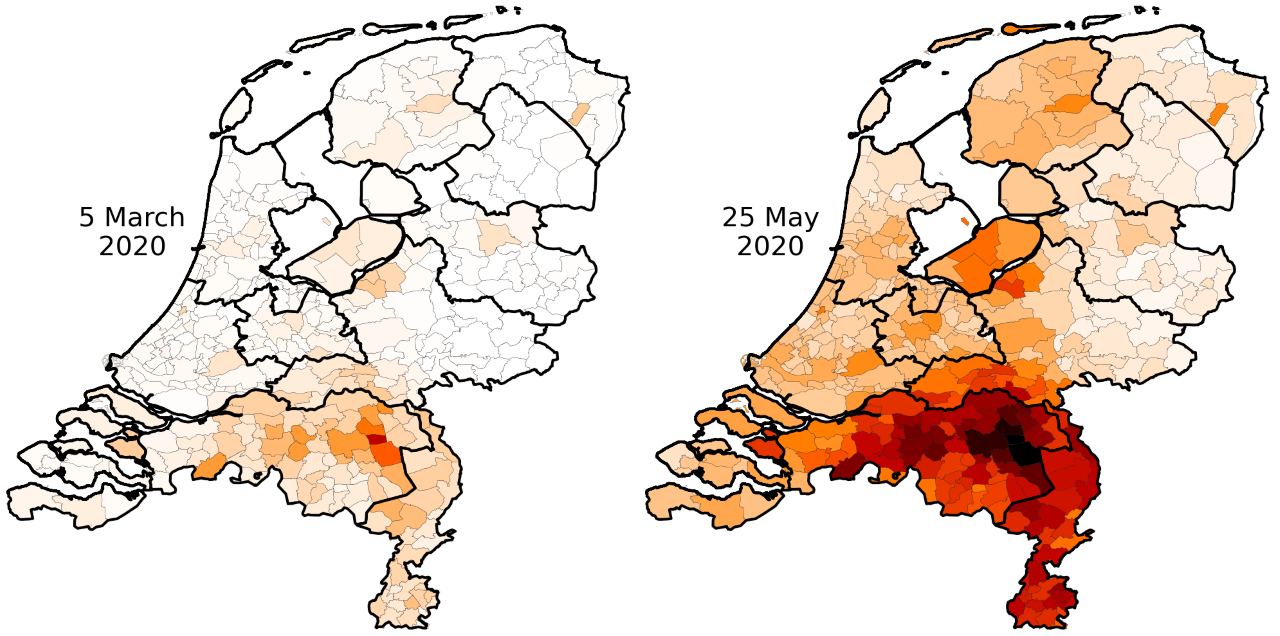Model study shows that local measures could control pandemics while reducing societal impact
Approach could be used to make strategic choices for future epidemics
Analysis of the COVID-19 pandemic in the Netherlands suggests that locally targeted pandemic control measures could have been just as effective as national lockdowns. Researchers from Utrecht University, Erasmus MC and the University of Amsterdam conclude this based on a mathematical model that they developed. As the model can also be applied to other countries and pathogens, the findings could be used to develop public health policies that effectively balance control measures to reduce infection spread, while lowering their socio-economic impact. The results of the model study are published today in the scientific journal eLife.
Like in many countries, control of the first COVID-19 pandemic wave in the Netherlands was largely based on the nationwide implementation of measures such as lockdowns, social distancing and reduced mobility. The associated societal burden affected all areas of the country, while infections and the health-associated burden affected only some regions, for some of the time.
Impact on people
Deb Panja, assistant professor of Computer Science at Utrecht University and vice director of the Centre for Complex Systems Studies: “We wanted to know if only targeting control measures to the most affected areas would make it possible to better balance the control of the pathogen with the impact on people’s well-being and the economy.”
To try to address this question, Mark Dekker, first author of the paper and PhD candidate with Panja at the time, and colleagues built a model that included information on how people travel, mingle and interact in different municipalities in the Netherlands. This allowed the multidisciplinary team to predict whether subnational interventions would have led to poorer or comparable control of the pandemic in the country as a whole.
Model
Their model was built in several stages. First, the researchers grouped the Dutch population into several demographic categories and 380 municipalities. Groups of 100 people were defined as ‘agents’, resulting in roughly 170,000 agents in the model. The movements of the agents between municipalities were simulated at hourly resolution, based on the analysis of anonymised mobile phone signals and mobility data from Google. The team then determined the likelihood of mixing between agents within a municipality based on the type of activity the agents were engaged in – either ‘home’, ‘work’, ‘school’ or ‘other’.

Next, they added in information about COVID-19 transmission: every agent was labelled as ‘susceptible’, ‘exposed’, ‘infectious’ or ‘recovered’. ‘Susceptible’ agents could move to the ‘exposed’ category depending on the prevalence of infectious cases and expected contact rates. Layered on top of this were the pandemic control measures – movement restrictions and school closures – which mirrored those implemented at the national level during the first wave of the pandemic. The model was then used to predict trends in infection, which were converted into predicted hospital admissions.
Targeted approach
The model results for instance suggests that by targeting interventions subnationally, 167 municipalities could have remained without lockdown at the start of the first COVID-19 wave and 12 could still have remained open after five weeks, resulting in only 3.4% more hospital admissions. Such a targeted approach, based on information about infection levels in subnational areas, could mitigate the need for national lockdowns and has the potential to be expanded to other countries.
Future applications
Panja emphasizes that live infection data was not available during the pandemic, but that may be different for novel pathogens in the future. Panja: “With emerging methods and technologies such as sewage monitoring, and possible fast identification of disease biology, our study shows that a more regionally targeted approach could significantly reduce the societal burden of lockdowns to control infectious diseases.”
With this model, we provide a handle to policymakers to find a balance between the control of an epidemic and people’s well-being.
The researcher explains that the model is transferable to other countries and pathogens, as long as the necessary data on how people in that country behave, travel and mingle (the “local contexts”) and how the disease is transmitted are available. Panja: “With this model, we provide a handle to policymakers to find a balance between the control of an epidemic and people’s well-being. It is really good to have something like this ready on the shelf. But we should be careful not to simply pick the model calibrated for country A and blindly apply to country B, keeping in mind that the local contexts are indeed country-specific.”
Publication
Reducing societal impacts of SARS-CoV-2 interventions through subnational implementation
eLife, 7 March 2023
Mark M. Dekker, Luc E. Coffeng, Frank P. Pijpers, Debabrata Panja, and Sake J. de Vlas

